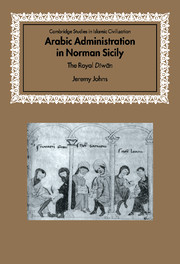Book contents
- Frontmatter
- Contents
- Preface
- Tables
- Abbreviations
- Genealogical table of the De Hautevilles of Sicily
- Note on Measurements
- Introduction
- 1 ‘In the time of the Saracens …’
- 2 ‘When first the Normans crossed into Sicily …’
- 3 ‘Our lady, the Regent Adelaide, and our Lord, the Count Roger, her son’, 1101–30
- 4 The earliest products of the royal dīwān, 1130–43
- 5 The jarāʾid renewed, 1144–5
- 6 The records of the royal dīwān. Part I: the jarāʾid al-rijāl
- 7 The records of the royal dīwān. Part II: the dafātir al-ḥudūd
- 8 The duties and organisation of the royal dīwān, 1141–94
- 9 ‘The people of his state’. The ‘palace Saracens’ and the royal dīwān
- 10 The Norman dīwān and Fāṭimid Egypt
- 11 Royal dīwān and royal image
- Appendix 1 Catalogue of dīwānī documents
- Appendix 2 Provisional catalogue of private documents
- Appendix 3 Abū Tillīs – ‘Old Wheat-sack’
- List of References
- Index
- Titles in the series
Appendix 3 - Abū Tillīs – ‘Old Wheat-sack’
Published online by Cambridge University Press: 10 March 2010
- Frontmatter
- Contents
- Preface
- Tables
- Abbreviations
- Genealogical table of the De Hautevilles of Sicily
- Note on Measurements
- Introduction
- 1 ‘In the time of the Saracens …’
- 2 ‘When first the Normans crossed into Sicily …’
- 3 ‘Our lady, the Regent Adelaide, and our Lord, the Count Roger, her son’, 1101–30
- 4 The earliest products of the royal dīwān, 1130–43
- 5 The jarāʾid renewed, 1144–5
- 6 The records of the royal dīwān. Part I: the jarāʾid al-rijāl
- 7 The records of the royal dīwān. Part II: the dafātir al-ḥudūd
- 8 The duties and organisation of the royal dīwān, 1141–94
- 9 ‘The people of his state’. The ‘palace Saracens’ and the royal dīwān
- 10 The Norman dīwān and Fāṭimid Egypt
- 11 Royal dīwān and royal image
- Appendix 1 Catalogue of dīwānī documents
- Appendix 2 Provisional catalogue of private documents
- Appendix 3 Abū Tillīs – ‘Old Wheat-sack’
- List of References
- Index
- Titles in the series
Summary
In his biography of George of Antioch (above, p.81), al-Maqrīzī employs the kunya or nickname Abū Tillīs for one of the protagonists. The meaning of this name rests upon two interdependent considerations: whether it belongs to cAbd al-Raḥmān or to Roger; and the precise meaning of tillīs.
The Arabic reads kataba ilā l-sulṭāni cAbdi l-Raḥmāni wazīri l-maliki Rūjāra bni Rūjāra maliki l-faranji l-ma crūfi bi-Abī Tillīsin ṣāḥibi jazīrati Ṣiqillīyata (‘he wrote to the sultan cAbd al-Raḥmān, the vizier of King Roger, son of Roger, king of the Franks, known as Abū Tillīs, lord of the island of Sicily’).
The word-order of the Arabic, which is reproduced exactly in the English translation, is not decisive, but strongly suggests that Abū Tillīs is employed of Roger. Only if it were possible to show that the phrase sāḥib jazīra Ṣiqillīya, ‘lord of the island of Sicily’, belonged to cAbd al-Raḥmān, rather than to Roger, could a strong syntactical case be made that Abū Tillīs also belonged to him. Indeed, Adalgisa De Simone assumes that both the kunya Abū Tillīs and the title ṣāḥib jazīrati Ṣiqillīya belonged to cAbd al-Raḥmān.
- Type
- Chapter
- Information
- Arabic Administration in Norman SicilyThe Royal Diwan, pp. 326 - 328Publisher: Cambridge University PressPrint publication year: 2002



